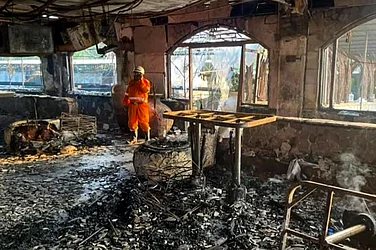While the latest budget aims to create six million jobs over the next five years, the spectacle of the recent, large-scale agitations in Bihar and Uttar Pradesh indicate deep-rooted anxieties of the unemployed youth as a ‘nowhere generation’. The fact that over 1.2 crore youths applied for 35,000 jobs with the Indian Railways and were furious at the lack of transparency in the selection process, brought forth simmering tensions between the demand for employment and the government’s policy responses to it.
On the one hand, the ever-increasing concern of unemployment restricts the potential of transformative development; on the other, it highlights the crumbling of expectations and aspirations of youths. In 2014, a large share of voters was displeased with the UPA government because of a perception of massive corruption about it, along with concerns over women’s safety and the government’s inability to meet the demands for jobs.
The NDA was voted to power as it promised to overcome corruption, generate large-scale employment opportunities and rapidly develop the country. Initially, the NDA government did initiate several development projects, be it Swachh Bharat Mission, Smart City Mission, Start Up India or Make In India, but it started faltering by 2016-17. The phase was marred by a contraction in economic growth along with rising joblessness. The falling economic growth has not shown any sign of recovery yet. The annual growth rate of per capita net national income of the country slid down from 6.29 per cent in 2016-17 to 2.5 per cent in 2019-20 (with only the last week of the financial year attributable to Covid-19 lockdowns) to -8.4 per cent in 2020-21 (with a recovery of 8.4 per cent in 2021-22, as per Economic Survey 2021-22).
Among others, this massive decline in economic growth has led to an unprecedented rise in the unemployment rate in the country. Rather than creating pro-employment policies and investing in the public sector, which generates more employment, the government is privatising it. Not only is the private sector more capital intensive, it has also tried to casualise employment by hire-and-fire schemes and low wages. Counterproductive policies, from demonitisation to GST, did unprecedented damage to the informal sector and micro and small enterprises, on which over 90 per cent of the country’s workforce depends. Not to mention the lack of empathy in dealing with migrant workers stranded by the 2020 lockdown. Though crisis loomed large, the government has largely been looking the other way, rather than creating enabling policies and extending substantive support to workers affected by the mayhem.
While liberalisation-led economic growth enabled about 1.4 per cent of the population to move into the middle class per year between 1993-94 and 2015-16, recent studies show that unsuitable policies may have pushed millions into poverty in the years that followed. A recent Oxfam report, ‘Inequality Kills’, argues that over 46 million Indians fell into extreme poverty in 2020, while the number and wealth of billionaires in India surged, crushing a considerable share of the total population under the burden of severe inequality.
The data also indicates decline in wages of two-thirds of the rural population in the last five years, accentuating the distress. A large share of the country’s population is without assets, while most of those into farming hold small land parcels. They sustain their households with menial jobs and low income, but aspire to a brighter future for their children by educating them, hoping that they enter the public sector or other better paying jobs. The agitations for reservations in employment by farming communities like Jats, Gujjars, Patels and Marathas; agitations by Dhangars in Maharashtra and demand for reservations by lower caste Muslims and Christians in several states; with upper castes pitching EWS (economically weaker sections) reservation against caste-based reservations—are examples of how employment matters to different segments of the population in order to raise or maintain their economic status. However, low, jobless growth has severely dismayed them and their younger generations. Their anger has occasionally been erupting across the country.
It was affordable higher education and employment in the public sector that once made economic mobility possible for significant numbers of SCs, STs, OBCs and EWS. However, the neglect of higher education by the government, by not increasing budgetary allocations on the one hand, and pushing privatisation on the other, will make higher salary jobs inaccessible for those unable to get through the quota system, blocking any possibility of their economic mobility. This may freeze Indian society into its existing social and economic stratification, creating and sustaining massive social injustices inherent in our social and economic structures based on caste, religion, gender and ascriptive bases.
Data from the Centre for Monitoring Indian Economy (CMIE) shows the country has been affected by severe unemployment since 2016. At the all-India level, the unemployment rate was 8.7 per cent in January 2016. It rose to a high 23.5 per cent in April 2020 (during the lockdown), but was 7.9 per cent in December 2021 and 6.6 per cent in January 2022. Between January 2016 and January 2022, the average unemployment rate in the country was as high as 7.38 per cent, with many of the states like Haryana (with average unemployment rate 19.26 per cent), Jammu and Kashmir (15.41 per cent), Rajasthan (12.18 per cent), Bihar (10.38 per cent), Uttar Pradesh (7.88 per cent) facing a worse situation.

Rural MNREGA Employment generating schemes increase consumer demand
The open unemployment rate in urban areas has been more severe than in rural areas, where a large number of workers remain engaged in disguised employment with low wages. As against 7.92 per cent in rural areas in January 2016, the unemployment rate in urban areas was 10.44 per cent in the same month. The urban unemployment rate went as high as 24.95 per cent during April 2020, as against the rural unemployment rate of 22.89 per cent. In May 2021 and January 2022, urban employment rate was 14.72 per cent and 8.16 per cent, against rural unemployment rate of 10.55 per cent and 5.84 per cent, respectively. Besides, unemployment has been more severe in the younger age group than those in higher age categories, indicating that new jobs are not being generated in the required numbers to absorb new entrants in the market, and those holding their jobs are somehow able to sustain them.
Comparing the January-April 2016 period with the October-December 2021 period, one finds that the situation for new entrants has worsened in the latter period. The unemployment rate in the age groups of 15-19 years, 20-24 years, and 25-29 years was 44.9 per cent, 26.8 per cent and 9.9 per cent, respectively, during January-April 2016, which increased to 56.44 per cent, 41.31 per cent, and 12.84 per cent, respectively during October-December 2021. The data illustrates the abysmal situation for aspirant youths who were often fed with political promises of better economic futures. This also underscores that we are far from reaping benefits of the demographic dividend, which is crucial for national development.
The glaring data needs to be comprehended alongside the major causes behind the high unemployment scenario. Firstly, it is the government’s economic policy, which has already been subjected to much criticism, both internally and outside the country. Simply put, the policies are not in sync with India’s social and economic reality, nor with the expected rates of employment and educational opportunities they need to generate. Secondly, today’s youth are aspirants who hope to work in better paying sectors like manufacturing and services, rather than agriculture and related sectors. There is nothing wrong with that as they want to attain economic mobility through better wage expectations. Let’s not forget how PM Modi criticised—not entirely without merit—UPA’s MNREGA in Parliament, on the ground that it only gave survival wages.
Thirdly, privatisation of the public sector and infusion of new technologies and capital by the private sector, may make industries more efficient, but capital and technology-intensive private sectors could undermine the social objectives of development—creation of employment. Public undertakings, with some exceptions, largely carried the dual aim of production and employment. This underscores that at least for a decade or two, India needs to create slow reforms in the public sector with simultaneous infusion of private capital in some strategic sectors. The government should consider apt management of this transition to serve both objectives, of production and employment. Fourthly, relatively poorer states have become victims of religious politics, undermining effective development and adding to the adverse employment situation.
(This appeared in the print edition as "The Jigsaw of Unemployment")
(Views expressed are personal)
Abdul Shaban is professor at school of development studies, TISS, Mumbai
Manish K. Jha is professor at centre for community organisation and development practice, TISS, Mumbai






















